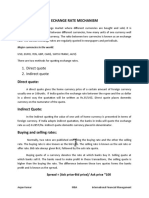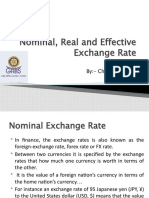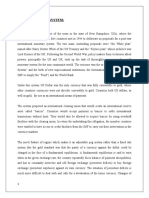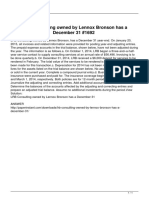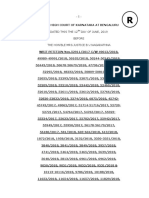Foreign Exchange Rate
Foreign Exchange Rate
Uploaded by
samchannuCopyright:
Available Formats
Foreign Exchange Rate
Foreign Exchange Rate
Uploaded by
samchannuCopyright
Available Formats
Share this document
Did you find this document useful?
Is this content inappropriate?
Copyright:
Available Formats
Foreign Exchange Rate
Foreign Exchange Rate
Uploaded by
samchannuCopyright:
Available Formats
Foreign Exchange Rate In finance, the foreign exchange rates or exchange rates or FX ratesbetween two currencies specify how
much one currency is worth in terms of other. For example an exchange rate of 50indian rupees to US Dollar means that INR 50 is worth same as USd 1. Quotations An exchange rate quotation is given by stating the number of units of term currency that can be bought in terms of 1 unit currency known as base currency. For example, in a quotation that says the USD/INR exchange rate is 50 i.e 50 Rs for each US dollar,the term currency is INR and the base currency is USD
Direct Vs Indirect quotation
A Direct quote is a quote where the exchange rate is expressed in terms of number of units of domestic currency per unit of foreign currency Example: Rs/$ : 48.62/48.72 Here the bank would be buying dollars @ 48.60/$ and selling dollars @ 48.72/$. An indirect quote is where the exchange rate is expressed in terms of number of units of the foreign currency for a fixed number of units of domestic currency. Example: $/100 Rs : 2.0525/67 Here the bank would be buying dollars @$2.0567/Rs100 and selling dollars @ 2.0525/Rs100. Before August 2, 1993, the indirect methods of quoting exchange rates used to be followed in India. Since that date, however, the direct quotes are used.
American Vs. European quote
A quote can be classified as European or American only if one of the currencies is the dollar. An American quote is the number of dollars expressed per unit of some other currency, while a European quote is the number of units of any other currency per dollar For example, Rs48.28/$ is a European quote, while $1.6698/GBP is an American quote. In almost all the countries exchange rates are expressed as European quotes. The British Pound , the south African Rand are few examples of currencies expressed in American quotes.
Bid and Ask Rate
In rupee Dollar exchange market , banks act as a market makers. This means that bank is ready to both buy and sale the currency at some rate. Therefore, the rate at which bank is ready to buy dollar will be different from the rate at which it stands ready to sell that currency. This rates are called bid and ask rates respectively. Example: Rs/$ : 48.60/48.72 Here the bank is ready to but dollars @ 48.60 and at the same time ready to sell dollars @48.72 The difference in these rates represents the cost the bank incurs in the transactions, and a small return on the capital employed, and the compensation for the risk it takes. . The difference between the bid rate and ask rate is called the bid ask spread, or simply the spread. The spread is seen higher in retail market then in interbank market There is counterparty risk, lower liquidity and high risk of transaction being set off at a disadvantageous rate in the retail market and therefore higher spread.
Interbank Quote Vs. Merchant Quote Merchant quote is given by a bank to its retail customers. On the other hand, a quote given by one bank to another or any other player in interbank market is called interbank quote. According to FEDAI rules, exchange rates in the merchant as well as interbank markets are to be quoted up to 4 decimals, with last two digits being in multiples of 25(for example: Rs/ $:48.6250/75). The card rates of banks should be either quoted in two decimals, or quoted in 4 decimals with last two digits being 0.
Exchange Rate System
There are different ways in which the exchange rate can be determined. Exchange rates may be free Floating or with limited flexibility.
Fixed Vs Floating Exchange rate system
Under the fixed exchange rate system the value of one currency in terms of another is fixed. These rates are determined by the governments or central banks of the respective countries. The fixed exchange rates results from countries pegging their currencies to either some common commodity or some particular currency There is generally some provision of some correction of these fixed rates in case of a fundamental disequilibirium Examples of this system are Gold standard and the Bretton Woods system Under floating rate system, the exchange rate between the currencies is variable. These rates are determined by the demand and supply of the currencies in international market. Exchange rates depend on the flow of money between the countries, which may either result due to trade in goods and service, or due to purely financial flows In case of deficit or surplus in the BOP, difference in interest rates , inflation rates etc automatically gets adjusted The exchange rate is said to be freely floating when its movements are totally determined by the market. There is no intervention at all either by the government or by central banks. This system is also known as clean float. The volatility of exchange rates associated with the clean float increases economic uncertainity faced by players in the international markets. In order to reduce these inefficiencies, central bank generally intervene in the currency markets to smoothen the fluctuations. Such system is referred to as a managed float or dirty float. In India managed float is practiced where RBI from time to time intervene the currency market to stabilize it by buying or selling dollar Nominal and Real exchange rates The nominal exchange rate is the price in domestic currency of the unit of a foreign currency. The real exchange rate (RER) is defined as RER=e(p*/p), where p* is the domestic price level and p is the foreign price level. It measures the countrys competitiveness in international trade. The RER is only a theoretical concept. In practice, there are many foreign currencies and price level values that are to be considered. Correspondingly, the model calculations become increasingly more complex.
More recent approaches in modeling the RER employ a set of microeconomic variables, such as relative productivity and the real interest rate differential NR=(RR+1)(Expected inflation+1)-1 Bilateral Vs Effective exchange rate Bilateral exchange rate involves a currency pair, while effective exchange rate is weighted average basket of foreign currencies, it can be viewed as an overall measure of countrys external competitiveness. A nominal effective exchange rate(NEER)is weighted with trade weights. A real effective exchange rate (REER) adjusts NEER by appropriate foreign price level and deflates by the home country price level. Compared to NEER, a GDP weighted effective exchange rate might be more appropriate considering the global investment phenomenon.
You might also like
- Fera and Fema: Foreign Exchange Regulation Act & Foreign Exchange Management ActDocument8 pagesFera and Fema: Foreign Exchange Regulation Act & Foreign Exchange Management ActMayank JainNo ratings yet
- Echange Rate Mechanism: 1. Direct Quote 2. Indirect QuoteDocument4 pagesEchange Rate Mechanism: 1. Direct Quote 2. Indirect Quoteanjankumar100% (1)
- Nominal, Real and Effective Exchange RateDocument9 pagesNominal, Real and Effective Exchange Ratechiragec2550% (2)
- Foreign Exchange Market NotesDocument2 pagesForeign Exchange Market NotesNilish ShakyaNo ratings yet
- Foreign Exchange Management Act - 2Document48 pagesForeign Exchange Management Act - 2Vaibhav VermaNo ratings yet
- Exchange Control in IndiaDocument3 pagesExchange Control in Indianeemz1990100% (5)
- Unit 3 - Foreign Exchange MarketDocument3 pagesUnit 3 - Foreign Exchange MarketmanishaNo ratings yet
- Exchange Rate Mechanism.Document7 pagesExchange Rate Mechanism.shaunak goswamiNo ratings yet
- Unit 2 - International Financial ManagementDocument20 pagesUnit 2 - International Financial ManagementSoma3010No ratings yet
- 1 Meaning and Function of Foreign Exchange Market 2 Types of Foreign Exchange MarketsDocument14 pages1 Meaning and Function of Foreign Exchange Market 2 Types of Foreign Exchange MarketsAnonymous GueU02hBdNo ratings yet
- Tandon Committee Report On Working CapitalDocument4 pagesTandon Committee Report On Working CapitalMohitAhuja100% (1)
- Chapter-I: Arbitrage, Speculation & Hedging in Forex MarketDocument62 pagesChapter-I: Arbitrage, Speculation & Hedging in Forex Marketmanojbhatia1220No ratings yet
- International FinanceDocument56 pagesInternational FinanceSucheta Das100% (1)
- Basics of International FinanceDocument59 pagesBasics of International FinanceAnuj Joshi100% (1)
- Unit 2 Financial System and Its ComponenetsDocument54 pagesUnit 2 Financial System and Its Componenetsaishwarya raikar100% (1)
- Concept of Demand: Willing AbleDocument13 pagesConcept of Demand: Willing AbleHarish Lodhi100% (1)
- The Foreign Exchange MarketDocument16 pagesThe Foreign Exchange Marketmanojpatel5167% (3)
- ADR and GDRDocument22 pagesADR and GDRsaini_randeep2No ratings yet
- Evolution and Function of MoneyDocument14 pagesEvolution and Function of MoneyGhulam HasnainNo ratings yet
- Indian Money Market and Capital MarketDocument17 pagesIndian Money Market and Capital MarketMerakizz100% (1)
- Chapter 14 - Exchange Rates and The Foreign Exchange Market An Asset ApproachDocument33 pagesChapter 14 - Exchange Rates and The Foreign Exchange Market An Asset ApproachNur AtikaNo ratings yet
- Depository System in IndiaDocument22 pagesDepository System in Indiamishra_shashishekhar97No ratings yet
- Microeconomics IIDocument26 pagesMicroeconomics IInigusu deguNo ratings yet
- CH 2 Banking Regulation ActDocument3 pagesCH 2 Banking Regulation Actpriyanka aroraNo ratings yet
- Balance of Payment: Meaning and ComponentsDocument6 pagesBalance of Payment: Meaning and ComponentsForum DaghaNo ratings yet
- Money and Banking PDFDocument19 pagesMoney and Banking PDFMOTIVATION ARENANo ratings yet
- What Is A "Derivative" ?Document4 pagesWhat Is A "Derivative" ?RAHULNo ratings yet
- Credit Control in India - WikipediaDocument20 pagesCredit Control in India - WikipediapranjaliNo ratings yet
- Depository System in IndiaDocument10 pagesDepository System in Indiababloorabidwolverine100% (2)
- Interlink Between Money and Capital MarketsDocument2 pagesInterlink Between Money and Capital MarketsDeepali Patil100% (1)
- Forex Market in IndiaDocument24 pagesForex Market in IndiaHarshUpadhyayNo ratings yet
- Cross Rate-1Document3 pagesCross Rate-1Hola GamerNo ratings yet
- Financial Market in IndiaDocument8 pagesFinancial Market in IndiaAashutosh ChandraNo ratings yet
- Money Market's InstrumentsDocument20 pagesMoney Market's InstrumentsManmohan Prasad RauniyarNo ratings yet
- International Financial MarketsDocument42 pagesInternational Financial Marketschitu1992No ratings yet
- Types of FdiDocument4 pagesTypes of FdiAditya Paul Sharma100% (6)
- Evolution of The Indian Financial SectorDocument18 pagesEvolution of The Indian Financial SectorVikash JontyNo ratings yet
- Balance of Payment AdjustmentDocument37 pagesBalance of Payment AdjustmentJash ShethiaNo ratings yet
- Factors Affecting Marketing MixDocument11 pagesFactors Affecting Marketing Mixmanjusri lalNo ratings yet
- Bretton Woods SystemDocument9 pagesBretton Woods SystemAshish PatelNo ratings yet
- Money MarketDocument20 pagesMoney Marketmanisha guptaNo ratings yet
- Foreign Exchange &Document13 pagesForeign Exchange &Amal JerryNo ratings yet
- FedaiDocument3 pagesFedaiSourav AdiNo ratings yet
- 2.country Risk AnalysisDocument25 pages2.country Risk AnalysisRishab Jain 2027203No ratings yet
- Evolution of Financial SystemDocument12 pagesEvolution of Financial SystemGautam JayasuryaNo ratings yet
- Sources of Financial InformationDocument13 pagesSources of Financial InformationSanjit SinhaNo ratings yet
- CHP 6 AnsDocument4 pagesCHP 6 AnsEvelyn Yee QinNo ratings yet
- From Gatt To Wto: Irina Gabriela Rădulescu, Bogdan DumbrăvescuDocument11 pagesFrom Gatt To Wto: Irina Gabriela Rădulescu, Bogdan DumbrăvescuAyaNo ratings yet
- If MCQ 40 Nos.Document7 pagesIf MCQ 40 Nos.gowthamNo ratings yet
- Sebi GuidelinesDocument16 pagesSebi GuidelinesJerome P100% (1)
- Theories of Exchange RateDocument10 pagesTheories of Exchange RatesweetashusNo ratings yet
- Introduction To International TradeDocument30 pagesIntroduction To International TradeSudershan ThaibaNo ratings yet
- Commercial Banks in IndiaDocument29 pagesCommercial Banks in IndiaVarsha SinghNo ratings yet
- 15 International Working Capital Management: Chapter ObjectivesDocument16 pages15 International Working Capital Management: Chapter ObjectivesNancy DsouzaNo ratings yet
- Class - 1 Meaning, Nature, and Scope of Corporate FinanceDocument2 pagesClass - 1 Meaning, Nature, and Scope of Corporate FinancemonicaNo ratings yet
- Foreign Exchange Management Act (Fema)Document22 pagesForeign Exchange Management Act (Fema)Livin VargheseNo ratings yet
- FDIDocument15 pagesFDIpankajgaur.iabm30982% (11)
- Topic 8-Macroeconomics OpenEconomyDocument47 pagesTopic 8-Macroeconomics OpenEconomyPradeep VarshneyNo ratings yet
- Unit 2Document15 pagesUnit 2Aryan RajNo ratings yet
- Mechanics of Currency Dealing and Exchange Rate QuotationsDocument6 pagesMechanics of Currency Dealing and Exchange Rate Quotationsvijayadarshini vNo ratings yet
- LRB Consulting Owned by Lennox Bronson Has A December 31 PDFDocument1 pageLRB Consulting Owned by Lennox Bronson Has A December 31 PDFLet's Talk With HassanNo ratings yet
- A Study To Determine The Home-Buyer's Preferences Through Voice of CustomerDocument7 pagesA Study To Determine The Home-Buyer's Preferences Through Voice of CustomerIOSRJEN : hard copy, certificates, Call for Papers 2013, publishing of journalNo ratings yet
- ENTREPRENEURDocument5 pagesENTREPRENEURAira SoquinoNo ratings yet
- Business Management May 2017 Case StudyDocument4 pagesBusiness Management May 2017 Case StudybenniNo ratings yet
- Case Study Challenge: Season - 1Document3 pagesCase Study Challenge: Season - 1Ankit ChauhanNo ratings yet
- Name: Ghanashyam Birua ROLL NO: 14202261 Sec: B Dept.: Mba I Subject: Economics Assignment 3Document2 pagesName: Ghanashyam Birua ROLL NO: 14202261 Sec: B Dept.: Mba I Subject: Economics Assignment 3ChandanMatoliaNo ratings yet
- Porter's Competitive Advantage, RevisitedDocument4 pagesPorter's Competitive Advantage, Revisitedmwananzambi1850No ratings yet
- Curs 2 - Business Letters and EmailsDocument10 pagesCurs 2 - Business Letters and EmailsBogdan ColdeaNo ratings yet
- Technology TransferDocument31 pagesTechnology TransferPrasanth KumarNo ratings yet
- Subject: Investigation in The Case Number VIII/ICD/6/TKD/SIIB/6AG/108/11 (Importer: Global Logic India PVT Ltd-EOU)Document4 pagesSubject: Investigation in The Case Number VIII/ICD/6/TKD/SIIB/6AG/108/11 (Importer: Global Logic India PVT Ltd-EOU)jainNo ratings yet
- Account Statement 1 Mar 2024 To 29 Jun 2024Document5 pagesAccount Statement 1 Mar 2024 To 29 Jun 2024maletekaisara5No ratings yet
- A Study On: "Customer Survey Report in Retatil Secctor"Document67 pagesA Study On: "Customer Survey Report in Retatil Secctor"Balakrishna ChakaliNo ratings yet
- Director Disqualification Judgment PDFDocument614 pagesDirector Disqualification Judgment PDFlakshmimenon39No ratings yet
- Sigmaguard 730Document5 pagesSigmaguard 730Vijay KumarNo ratings yet
- Brochure City Gas Distribution in India March2018 PDFDocument6 pagesBrochure City Gas Distribution in India March2018 PDFKunal BadhwarNo ratings yet
- Form of Tender-Rev04Document4 pagesForm of Tender-Rev04Manu MohanNo ratings yet
- Gaim Usa 2012Document20 pagesGaim Usa 2012mcampuzaNo ratings yet
- Case 5 - Johnnie Walker - Reigniting GrowthDocument6 pagesCase 5 - Johnnie Walker - Reigniting GrowthArah Ibrahim-MacakilingNo ratings yet
- Lbata 1990 Amendment Up To 2011 PDFDocument28 pagesLbata 1990 Amendment Up To 2011 PDFsyahiraNo ratings yet
- Unit 4.3 - Corporate Strategy and DiversificationDocument22 pagesUnit 4.3 - Corporate Strategy and Diversificationjulianne.habito.cthmNo ratings yet
- Operations ResearchDocument72 pagesOperations ResearchPrabhakar KumarNo ratings yet
- Financial Technology EnglishDocument10 pagesFinancial Technology EnglishHilmansyah AminNo ratings yet
- 3A Contractual Estoppel TFDocument17 pages3A Contractual Estoppel TFMutahar SahtoNo ratings yet
- Practical Accounting Training Work FileDocument9 pagesPractical Accounting Training Work Filelikhith.thomasNo ratings yet
- Annexure-2: Table: 1-ECAI's Credit Rating Categories Mapped With BB Rating GradeDocument1 pageAnnexure-2: Table: 1-ECAI's Credit Rating Categories Mapped With BB Rating GradeovifinNo ratings yet
- Course Outline-MIS-305 - Spring-2011Document4 pagesCourse Outline-MIS-305 - Spring-2011Oprichito AkjonNo ratings yet
- Maintenance Agreement ContractDocument4 pagesMaintenance Agreement Contractgigi556No ratings yet
- Business Continuity Planning Policy SampleDocument2 pagesBusiness Continuity Planning Policy SamplePatricio Alejandro Vargas FuenzalidaNo ratings yet
- Income Tax Act 1967Document458 pagesIncome Tax Act 1967Ian YongNo ratings yet

